|
| |
| |
DENIS
GIFFORD'S
MONSTERS OF THE
MOVIES
(1977)
|
|
Monster
#26 - The Gorgon
|
|
| |
|
| |
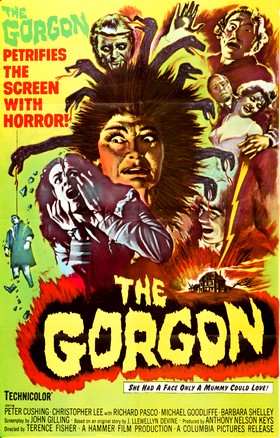 |
|

United
Kingdom, 1964
A Hammer Films Production
83 mins, colour, 1.66:1 aspect ratio
Director - Terence Fisher
Writer - J. Llewellyn Divine
Screenplay - John Gilling, Anthony Nelson Keys
Cinematographer - Michael Reed
Production Design - Bernard Robinson
Make-Up - Roy Ashton
Special Effects - Syd Pearson
Editor - James Needs, Eric Boyd-Perkins
Music - James Bernard
Peter
Cushing (Dr. Namaroff), Christopher Lee (Prof.
Karl Meister), Barbara Shelley (Carla Hoffman),
Richard Pasco (Paul Heitz), Michael Goodliffe
(Prof. Jules Heitz), Patrick Troughton (Inspector
Kanof), Prudence Hyman (The Gorgon)
|
|
| |
| PLOT
SUMMARY - By 1910, the village of
Vandorf has been paralysed for five years by a series of
mysterious deaths, yet the local doctor, Namaroff, has
been concealing the truth about them. The victims are all
turned to stone and Namaroff suspects that the derelict
Castle Borski is the home of Megaera, last of the
legendardy Gorgons. He also suspects that his assistant,
Carla, provides the human vessel through which Megaera
manifests herself. (Rigby, 2015) |
| |
|
| |
| The Gorgon, that fabled creature
with snakes nesting in her hair, was one of only
a handful of monsters in Denis Gifford's parade
that was something of a known entity to me. I had
read a fair share of books on Greek mythology,
since that was the closest thing to fantasy and
sword and sorcery a keen pre-teen reader could
get his hands on in the early 1970s. The Gorgon
is a movie that stands out a bit from Hammer's
usual fare.
For starters, it is based
on a story submitted by a fan of Hammer's movies,
J. Llewellyn Divine (Fellner, 2019). It is also
the first and last time Hammer delved into any
kind of classic mythology for their monsters -
which might explain why they also managed to get
it wrong: Megaera (Greek for "jealous
rage") is not a Gorgon but rather one of the
three Furies (Erinyes).
Also rather unsual was the
choice of actress for the Gorgon, casting former
ballerina Prudence Hyman for the role since the
monster was supposed to "float gracefully
like a wraith" (Fellner, 2019).
|
|
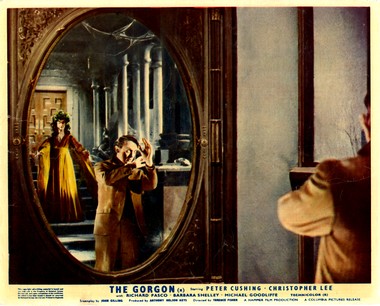
Original 1964 Lobby Card (personal
collection)
|
|
| |
The Gorgon was also both Terence Fisher's
first reunion with Peter Cushing and Christopher Lee
since The Mummy in 1959 as well as their last
work together as a trio. And finally, the make-up and
special effects used for the monster - commonly a strong
point for Hammer - is considered by many to have been a
complete let-down in the case of the Gorgon.
"[With] so
disappointing a monster, it's hardly surprising that
The Gorgon is not a fan favourite." (Rigby,
2015)
However, fixating on and
over-elaborating the handful of close-up shots of the
Gorgon's hair full of obviously fake snakes obscures the
many strong points and merits The Gorgon has -
possibly making it the most under-appreciated and
under-rated of all Hammer movies.
|
| |
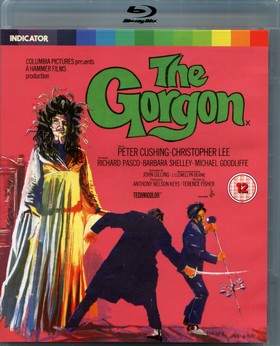
|
|
I deliberately stayed away from
this movie far too long, before finally watching
it for the first time on Powerhouse's 2020
Blu-ray release, which provides the viewer with a
gloriously high-definition rendition of both
image and audio. The Blu-ray also features a
number of extras, the most exciting of those
being a short documentary (aptly titled
"Heart of Stone") from 2017 on the
making of The Gorgon. First released
in the UK in October 1964 (and in the US in
February 1965), The Gorgon was produced with the
intention of creating a double-bill with The
Curse of the Mummy's Tomb as the supporting film
(Fellner, 2019).
The aforementioned strong
points of The Gorgon are its forceful
yet also very fine sense of atmosphere and dread.
This is supported by a storytelling that provides
both suspense and comic relief, without ever
slipping into the ridiculous, in spite of a plot
premise which - like most horror movies - could
easily be dismissed as being utterly ridiculous.
On top of all that, the
highly accomplished and varied visuals of The
Gorgon underscore and carry this tense and
unnerving atmosphere for the entire length of the
movie, with Gothic sets both beautiful and scary
in which the characters and the acting that
brings them to life also surpass the average
Hammer fare by far.
|
|
| |
| Terence Fisher actually
considered The Gorgon to be one of his best
films (Rigby, 2015), and he may very well have a point
there. Once people are able to put aside the snake
effects and possibly see the psychology of fear and
terror surrounding the Gorgon (which comes across very
strongly in all her scenes not featuring a close-up of
her head), reviews generally begin to see the merits of The
Gorgon. |
| |
"[The Gorgon] exerts
a certain funereal fascination, much enhanced by
excellent cinematography and production design. In
sharp contrast to the nocturnal moments in most
Hammer horrors, Michael Reed's day-for-night
photography in the opening scenes is remarkably
effective and (...) banishes all thought of that
familiar Hammer location, Black Park near Slough. And
though the film's low budget is betrayed by a few
exterior settings which are clearly painted
backdrops, the desolate Castle Borski, both inside
and out, is more impressive than any of Hammer's
various Castle Draculas." (Rigby, 2015)
|
| |
| |
|
| |
| |
| |
 |
|
Denis Gifford on The
Gorgon
in A Pictorial History of Horror
Movies (1973)
Apart from a still
depicting Prudence Hyman as the Gorgon,
Gifford makes no further mention of the
movie.
|
|
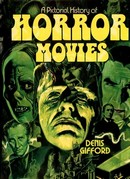 |
|
| |
|
| |
| |
| SOURCES FELLNER
Chris (2019) The Encyclopedia of Hammer Films,
Rowman & Littlefield
RIGBY Jonathan
(2015) English Gothic, 2nd edition, Signum Books
|
| |
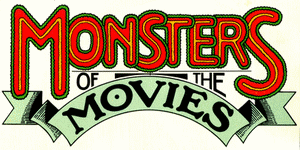
Back
to main index page
|
| |
|
| |
The illustrations presented here are
copyright material.
Their reproduction in this non-commercial review
and research context is considered to be fair use
as set out by the U.S. Copyright Act of 1976, 17
U.S.C. par. 107
and in accordance with the the Berne Convention
for the Protection of Literary and
Artistic Works.
All images from Monsters
of the Movies (Carousel/Transworld) were
scanned from my personal copy purchased in 1977
All images of Blu-ray or DVD covers were scanned
from my personal copies
All images of lobby cards were scanned from
copies in my personal collection
Page created 22
February 2023
Last updated 2 September 2023
(c)
2023

|
|
| |